Lens completed Ligue 1’s first major incoming transfer of the 2022 January transfer window when they announced the signing of Patrick Berg (175cm/5’9”, 70kg/154lbs) from Bodø/Glimt in mid-December, with the right-footed 24-year-old central midfielder having just captained his side to a second straight Norwegian Eliteserien title.
Captain Berg played a key role for his team this term, with his 2401 league minutes making him Bodø/Glimt’s fifth-most used player in the league this season. Berg also scored five goals and made five assists in his 31 appearances in all competitions for Bodø/Glimt this season, with three of those goals and three of those assists coming in the league. Berg notably scored one of his side’s goals in their emphatic 6-1 home UEFA Europa Conference League win in October versus José Mourinho’s Serie A side Roma, a win that helped Bodø/Glimt to finish the Conference League group stage in second place, trailing only Roma, booking the Norwegian side a place in the first knockout round in which they’ll face Scottish giants Celtic.
Before moving to Lens, Berg had also been linked to Celtic in reports, along with Turkish giants Galatasaray. However, the central midfielder has ultimately opted to make Stade Bollaert-Delelis his January destination where he’ll compete domestically with the likes of PSG, Marseille, Lyon and Lille. This has been described as a ‘shrewd’ move from Lens by some, with Spanish-speaking French football expert Andrés Onrubia Ramos going so far as to say that this €4m move is “an absolute bargain seeing the player’s potential”.
My aim with this tactical analysis and scout report is to provide Lens fans and Ligue 1 fans with a comprehensive breakdown of Berg, as a player. I hope to paint a clear picture of Berg and what he can offer Lens via this scout report. With this tactical analysis piece, I aim to highlight some of the key strengths and potential areas of improvement within the nine-cap Norway international’s game, as well as touch on how he may fit in for Franck Haise’s Les Sang et Or strategy and tactics. All stats and data used in this tactical analysis come from Wyscout unless stated otherwise.
Passing
Berg’s passing is the most interesting part of his game, for me. There are many strengths to his passing game and from a data perspective, this part of his game stands out more than any other. I’d be comfortable saying Berg is an asset in terms of ball retention and ball progression. With Bodø/Glimt, the 24-year-old was a high-volume passer, playing 58.1 passes per 90 this season (very high among Eliteserien central midfielders who played at least 600 minutes in 2021), with an equally very high 89.81% success rate.
Per Wyscout, a pass is ‘progressive’ if “the distance between the starting point and the next touch is 1. at least 30 meters closer to the opponent’s goal if the starting and finishing points are within a team’s own half, 2. at least 15 meters closer to the opponent’s goal if the starting and finishing points are in different halves, or 3. at least 10 meters closer to the opponent’s goal if the starting and finishing points are in the opponent’s half”.
Berg ranks highly in progressive passes amongst Eliteserien central midfielders for 2021, having played 7.5 per 90 with an impressive 77.5% success rate. He also plays plenty of successful passes into the final third (8.47 per 90, with an 84.57% success rate).
For me, Berg is at his best when playing in a deep playmaking position on the edge of the final third when his team is in the chance creation phase, playing versus a low-block. In this phase, the opposition will typically be packed into a compact low-block on the edge of their penalty box and by sitting deep on the edge of the final third, Berg can enjoy some time and space on the ball with runners ahead of him looking to receive a pass.
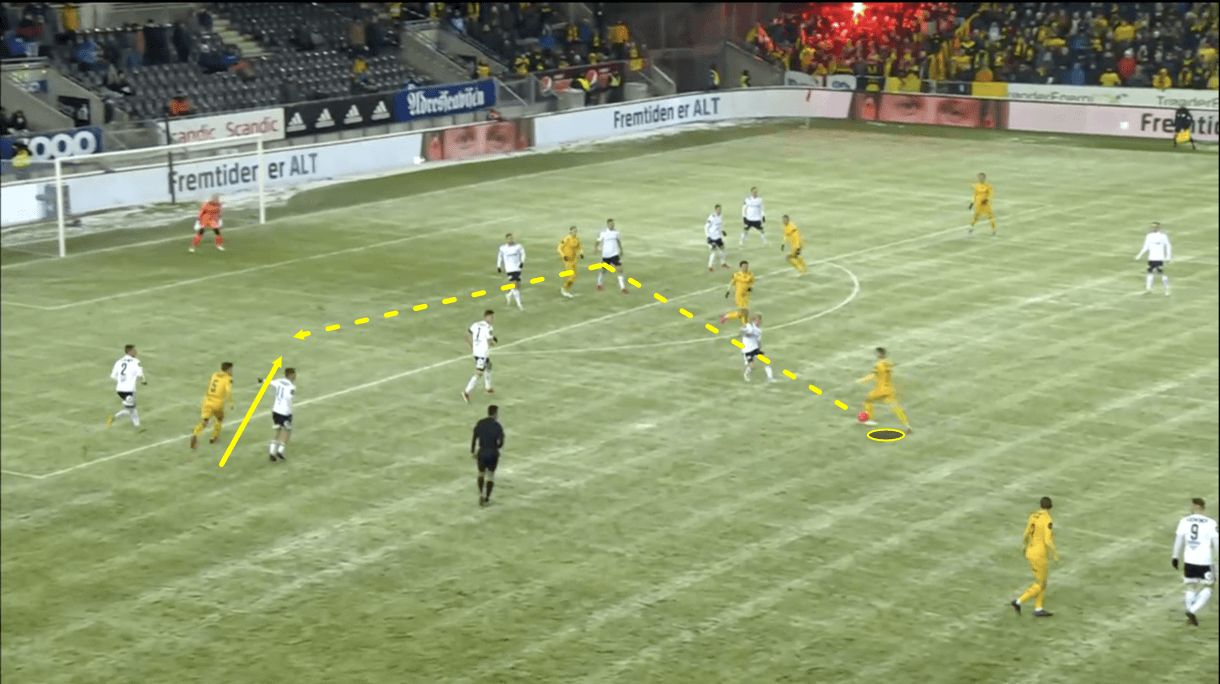
Figure 1 shows an example of Berg performing this role on the edge of the final third in the chance creation phase for Bodø/Glimt this season. In this example, while Bodø/Glimt progressed upfield, Berg sat deeper, just in front of his side’s backline, as he often does, with Berg typically playing as a sole holding midfielder in Bodø/Glimt’s 4-3-3 (4-1-2-3) formation this term. As his team moved into the final third, they forced the opposition back into the low-block we see here and this created space on the edge of the final third for Berg to push into, receive the ball, get his head up and pick out a runner into the opposition’s penalty area ahead of him, as we see above.
In this particular example, Berg showed off some impressive passing technique by delicately lofting a through ball into the path of the attacker running into the box from the left-wing. The pass was played with appropriate height so that it beat all the defenders between the two Bodø/Glimt players but also with enough care that it arrived into the path of the attacker without falling short or running too long. This is an example of Berg’s technical passing ability — he’s great at threading the ball through a tight space and he’s capable of playing creative, line-breaking passes while under pressure with precision. These skills, along with his initial intelligent off-the-ball movement and his vision, make him an excellent asset in this role in the chance creation phase.
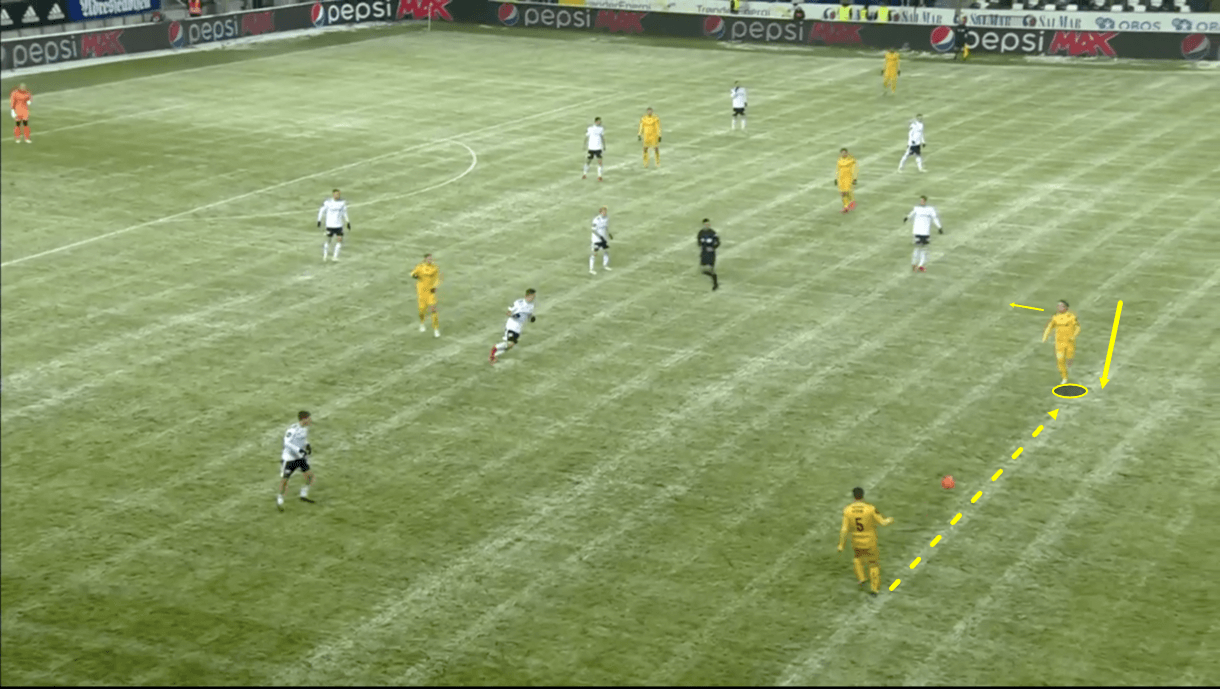
We see an example of Berg’s positioning in a slightly earlier phase of play — with his team looking to progress into the final third — in figures 2-4. In this phase, Berg is typically found centrally, just inside of the opposition’s half. However, he tends to move around a lot, getting drawn closer than may even be desired to the ball carrier, which we’ll analyse in greater detail as we progress deeper into this scout report. In figures 2-4, we’ll highlight Berg’s scanning, his tendency to receive passes well with an open body shape that helps him to then progress play and his long passing ability.
Firstly, in figure 2, we see Berg receiving the ball while moving towards the teammate who passed to him. As the ball leaves his teammate’s foot, he quickly scans over his right shoulder to anticipate incoming pressure and get a clearer picture of how the rest of the pitch ahead of him is laid out at the moment. This is an example of some really effective scanning, which is an evident part of Berg’s game. You constantly seeing him scanning in moments like this while the ball is moving. Why does he scan after the pass has been played but before the ball arrives to him? Because at this moment, nothing will change the course of the ball so he doesn’t benefit from watching it arrive as much as he benefits from scanning. This intelligent scan selection helps Berg to make a better informed and quicker decision after receiving the pass than he otherwise would.
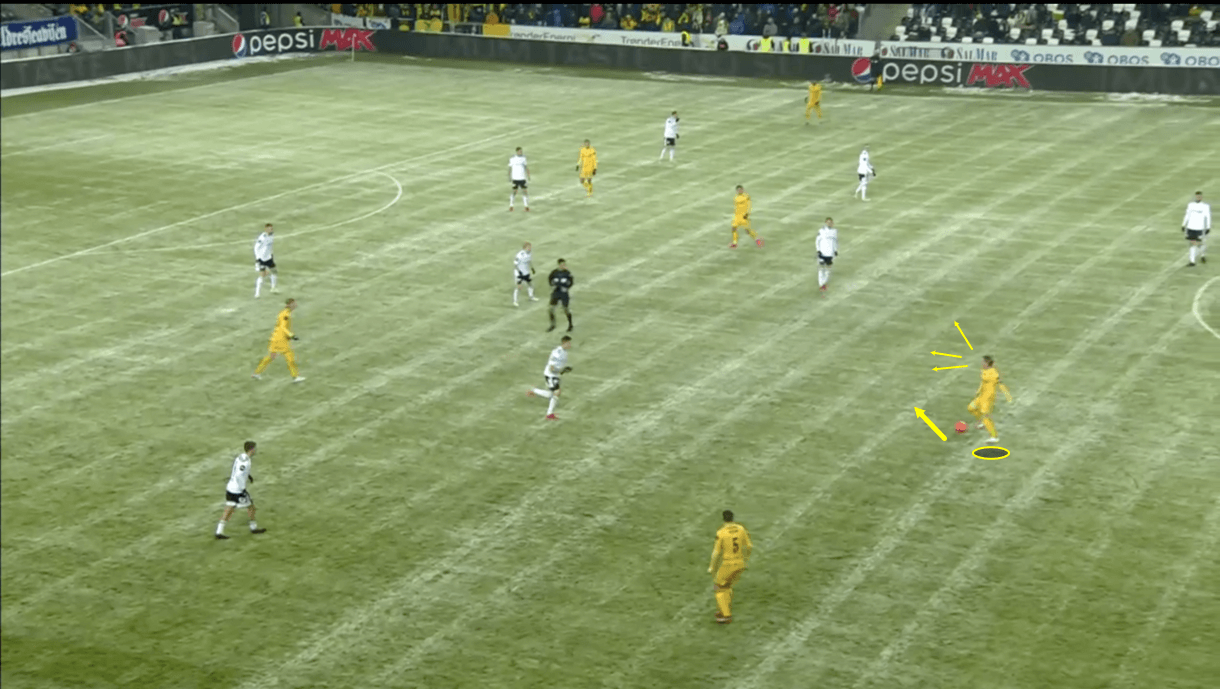
After a very brief scan, when the ball arrives, Berg gets his head back down and controls it while opening his body and turning towards goal, as we see in figure 3. At this moment, the Norwegian midfielder enjoys enough time and space to get his head up and look around to assess his options once again.
Berg is excellent at getting his head up when on the ball. He’s constantly trying to receive more and more information from the positioning and movement of players around him — both on his team and the opposing team. We also see him getting his head up and assessing the lay of the land around him very frequently and effectively when carrying the ball forward if he receives it in a deeper position with space to move into.
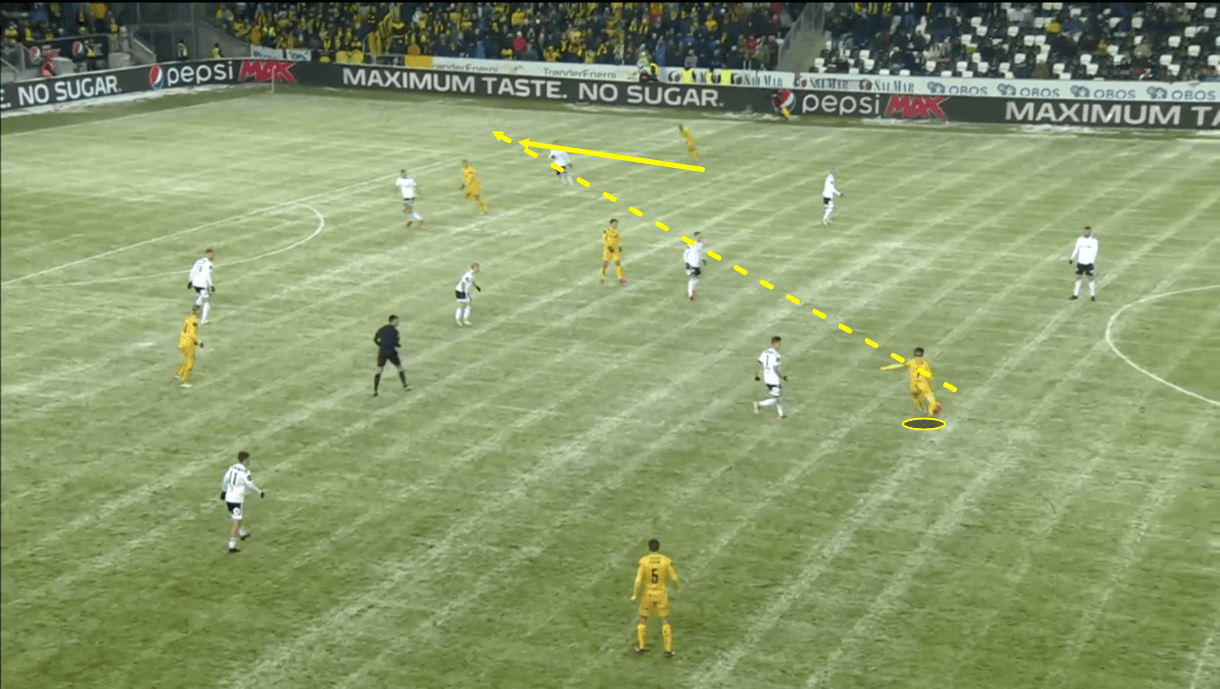
On this occasion, with the opposition playing in a compact 4-1-4-1 that protected the centre of the pitch well, Berg was prevented from playing a short progressive ball forward for, say, one of his central midfield partners to receive on the half-turn and carry into the final third. This left him with the options of either continuing to circulate possession deep while trying to forge an opening for that short progressive pass or, alternatively, playing a riskier long-range ball. As figure 4 shows, Berg opted for the long ball which cut through the opposition’s backline, between the left centre-back and left-back, with the aim of playing Bodø/Glimt’s right-sided width-provider through into the box.
Berg was unsuccessful on this occasion as the ball was actually played with a bit too much power, resulting in it running out of play but the idea was good and the execution was almost perfect too. Given that this is a very difficult pass to even see, let alone pull off, I feel this can still be seen as a positive example of Berg’s contribution for his side as a ball progressor. In figures 2 and 3, we saw how his effective scanning, body movement and first touch set him up perfectly to continue progressing play. While the execution of the final ball was off, Berg is constantly displaying these positive traits when receiving passes which bodes well for him continuing to create opportunities for progression like this more and more in the future.
As for his long passing, Berg played a fairly high 3.67 long passes per 90 in Eliteserien this season and retained a highly impressive 66.33% success rate. So while this particular example didn’t result in a successful execution, Berg is typically very reliable as a long passer. If you want a midfielder getting on the ball to switch play or drive a creative long pass over the opposition, Berg is an excellent option to have.
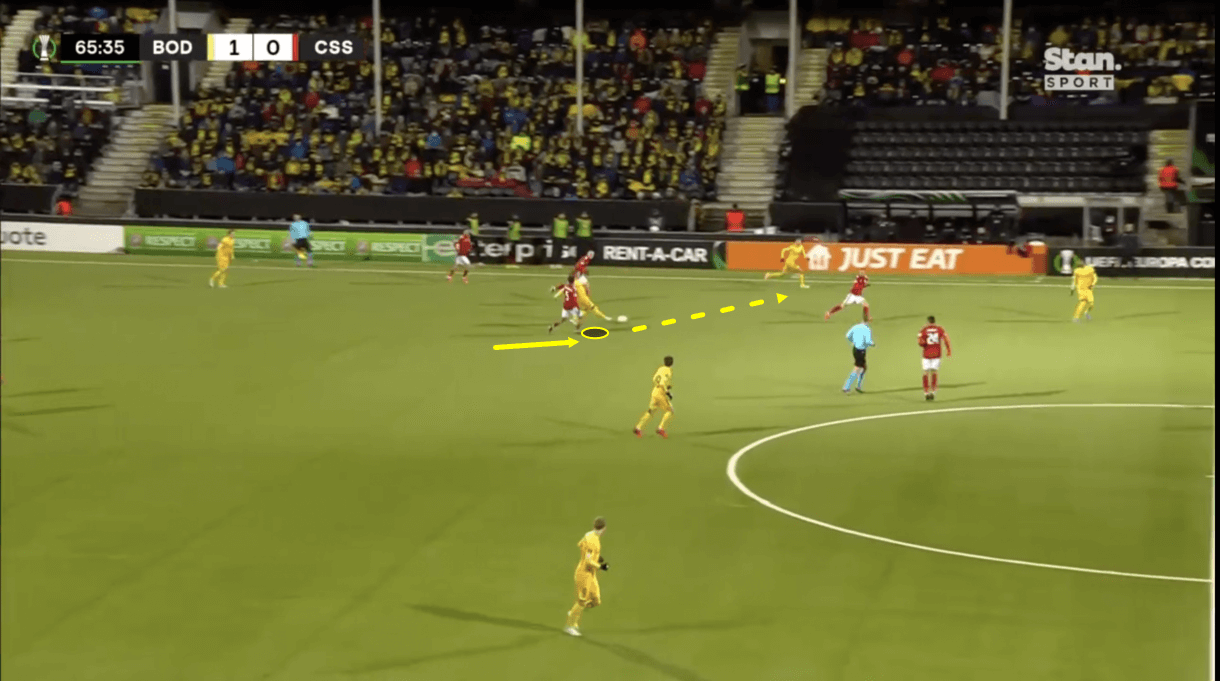
For me, the most notable thing of all about Berg’s passing is his ability to progress the ball upfield via quick one-twos and intricate link-up play. His solid technical ability and constant intelligent, effective scanning to invade space in between releasing and receiving the ball are crucial in such passages of play. Figures 5-8 highlight Berg helping his team to progress upfield via one-twos and intricate link-up play.
Firstly, figure 5 shows Berg starting this progression upfield from a deep position. Again, we see here how he’s not positioned centrally, but instead very wide on the left side of the pitch. Berg likes to roam about in his deep position behind the other two midfielders with Bodø/Glimt to get into wider areas like we see here. With that said, I do think trying to remain more central and stationary at times in the future would help him and his team, especially in the sole holding midfielder role. Firstly, if possession is lost with Berg roaming around, that leaves his team very vulnerable in the sensitive central position between midfield and defence. With Berg roaming around and nobody else filling in his position, it can also leave Bodø/Glimt somewhat bare in central midfield, which is a threatening area that they’d likely want to be occupying. Furthermore, by remaining central, Berg can attract opposition defenders to him which can then create space elsewhere for teammates.
However, a positive thing this image above shows is Berg’s ability to comfortably draw opposition players in towards him by holding onto the ball just long enough that they press but not long enough for them to tackle him. Just before that point is reached, Berg releases to the runner on the left-wing, setting him off to run into the space ahead of him.
It’s very common to see Berg calmly drawing pressure like this before releasing to a teammate in space at just the right moment. This can help give his teammate more time to progress into space while it can also help Berg to create space for himself to run into behind the near pressing player immediately after he releases the ball, as they won’t be protecting that space due to the fact they vacated it to press him.
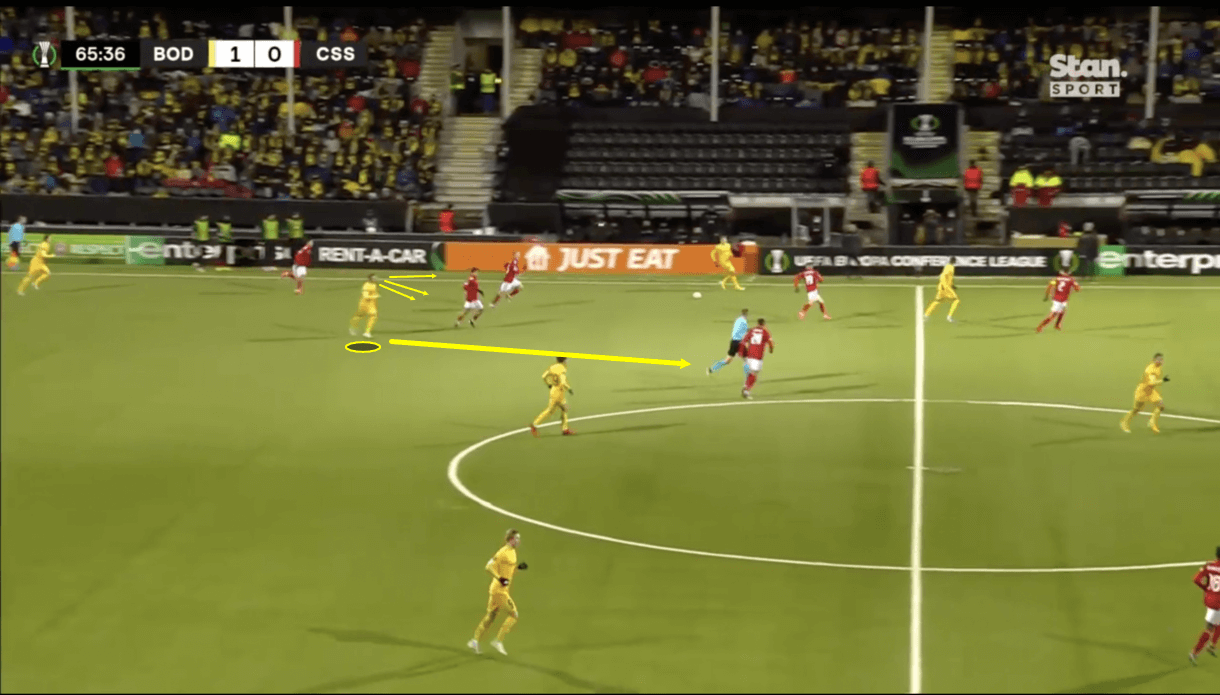
In figure 6, we see that after releasing the ball to the left-sided attacker, Berg immediately got his head up to scan. He sees space ahead of him to drive into and does so quickly while the nearest opposition defenders have turned their attention to pressing the new ball carrier receiving Berg’s pass in the image above.
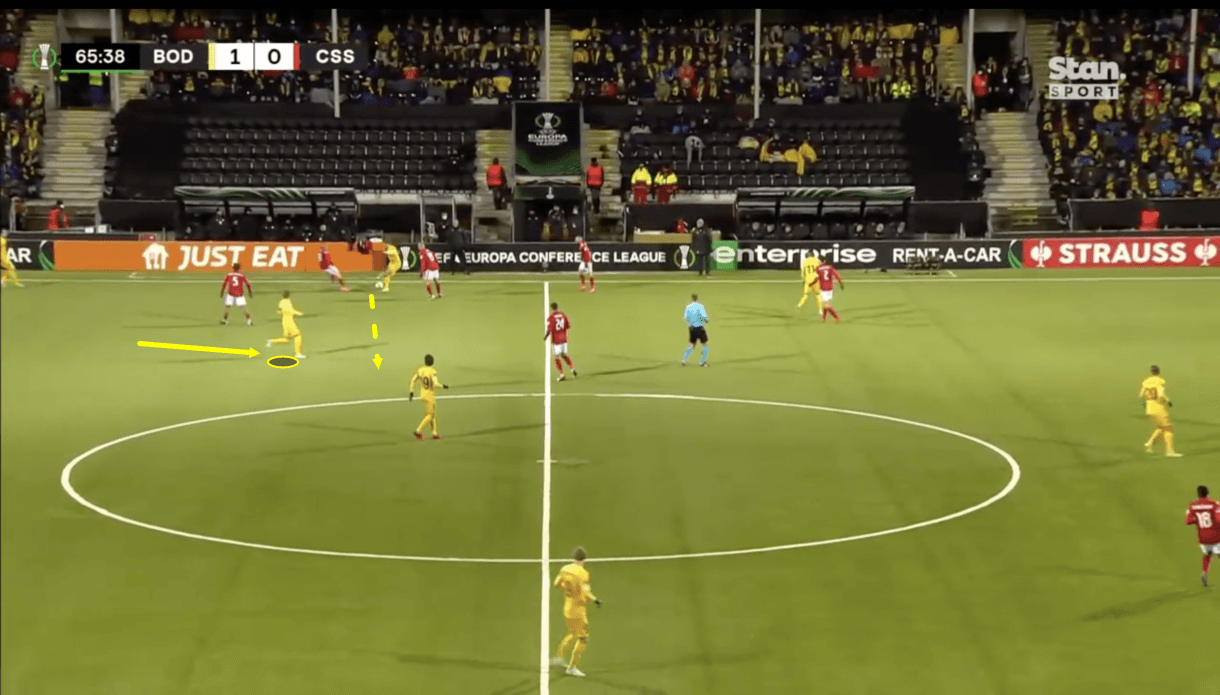
As the new ball carrier receives the ball, he acts similarly to Berg by waiting for the opposition pressure to increase — but not too much — before releasing in order to give the central midfielder time to progress past the midfielders with his off-the-ball movement and exploit the space he’s spotted ahead of him. In figure 7, we see the moment at which the ball carrier decided to release back to Berg, completing the one-two and setting him off into space in this left-sided central midfield position he’s now occupying.
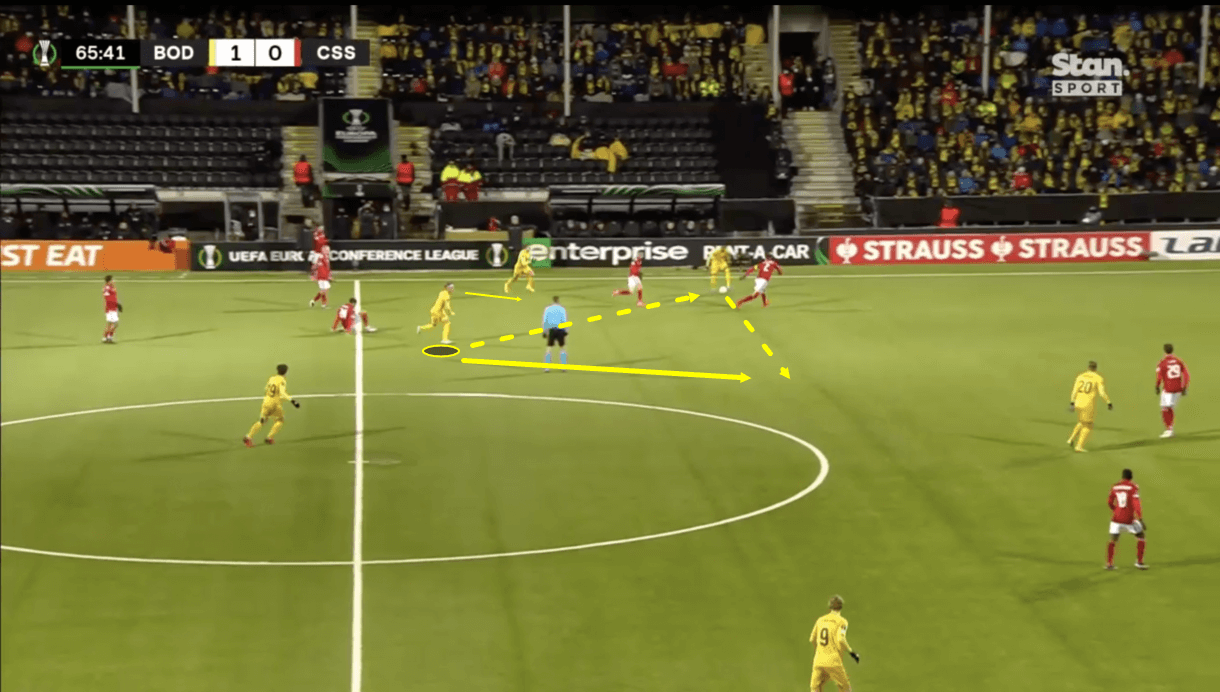
Berg again receives the pass well, carrying it forward and comfortably attracting some more pressure. In figure 8 and beyond, the central midfielder repeats the actions we saw in figures 5-7, this time with the more advanced left-winger — highlighting his gradual but effective progression upfield via his one-twos and link-up play. This type of progression is a common feature of his game — Berg is very effective at building upfield via technically sound short passes, intelligent off-the-ball movement and quick one-twos. He’s a player who loves to link up with teammates via short passes and will look to do so first and foremost before anything else.
In figure 8, we see that Berg again attracted pressure and bypassed it well by releasing to the wide man in support. He actually ended up leaving the opposition defender on the floor this time by releasing and bursting past so quickly and effectively. Again, in this image, we see Berg scanning the space ahead of him while his teammate out wide controls the ball, and as play moves on from here, we see the winger send the ball neatly back into Berg’s path for the 24-year-old to control and carry forward into the final third.
So, from this passage of play, I hope it’s clear how Berg’s technical ability and, probably most of all, his excellent off-the-ball movement and effective scanning help him to progress play, even if gradually and slowly. Expect to see Berg trying to set up one-twos like this with a view to progressing upfield when he arrives at Lens too. He will likely look to link up with Lens’ wing-backs and ‘number 10’ to achieve this.
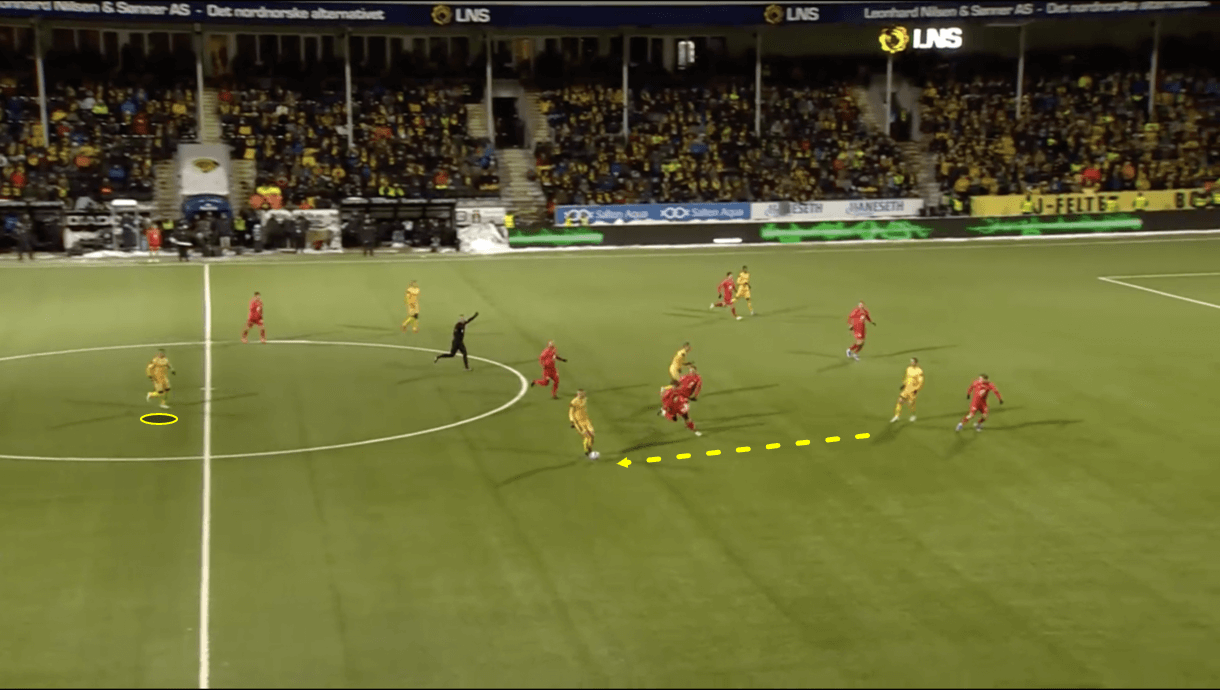
With the next couple of examples I’m highlighting, I will discuss some potential areas of improvement within Berg’s passing game. Firstly, figures 9-10 will look at Berg’s tendency to roam from his holding midfield position and get drawn towards the ball carrier. In figure 9, we see Bodø/Glimt’s right central midfielder receiving the ball while turning backwards under pressure from the opposition midfielders surrounding him. As he turns, his 24-year-old captain is positioned in space, in a valuable central position with a good view of the pitch in front of him. Had he just stayed put and scanned to get a good idea of the positioning and movement around him, he’d be in a perfect position to receive the ball from the right central midfielder and get his team moving forward again.
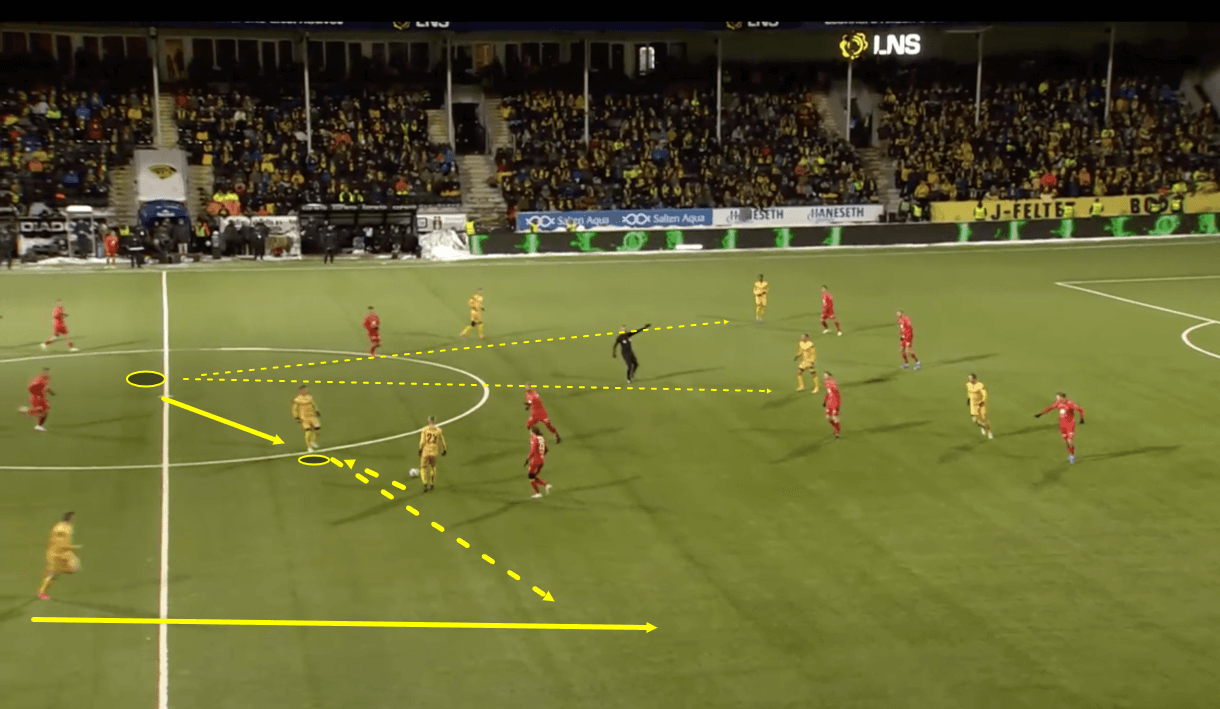
However, as figure 10 shows, Berg came far closer to the right central midfielder, which made the pass to him very simple for the right central midfielder but then limited his own options after receiving the ball. As play moves on, Berg actually choses a good option and executes his pass perfectly by lofting a delicate through pass out to the overlapping right-back who has space to run into on the right-wing, so Berg’s movement wasn’t disastrous by any means on this occasion. However, with a more central position similar to the one Berg had just departed marked on the image, we can see that if he’d just stayed put, the Norwegian midfielder would’ve had far more passing options that he would’ve had time to assess before receiving the pass if not for his decision to roam instead.
From a central position, Berg could’ve received this pass from the right central midfielder and then driven the ball forward via a progressive pass into the ‘number 10’ position, where one teammate is waiting at this moment, or the left half-space, where another couple of teammates are positioned at this moment. A pass into one of these areas would’ve left Bodø/Glimt in an even more threatening position than the one they ended up in, so while Berg’s pass in the end wasn’t a bad one, the opportunity cost of his decision to roam from the centre and get too close to the passer was quite big and in general, his team would likely benefit more from him being in the central position and availing of the central passing options than they would from him being in the position he was and choosing the option he did. As a result, I think Berg can benefit greatly from improving his positioning. Sometimes, you can support your teammate more by positioning yourself further from them than you can by positioning yourself closer to them.
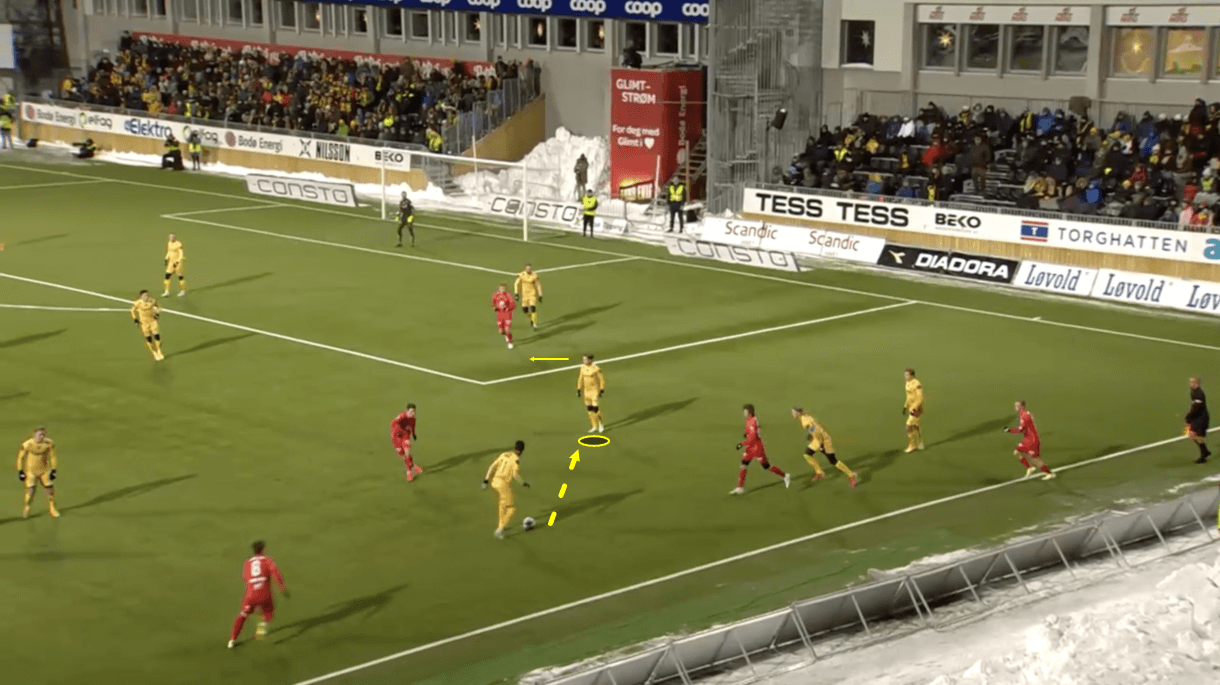
Additionally, I think Berg’s passing bravery and decision-making, especially in deeper areas, can improve. Figure 11 shows an example of Berg scanning effectively in between his teammate’s touches, while trying to receive information from the positioning and movement around him while anticipating opposition pressure in a very sensitive position where it’d be very dangerous to get dispossessed. We already discussed the benefits of this but the passage of play above shows yet another example of this good habit in action from Berg this season.
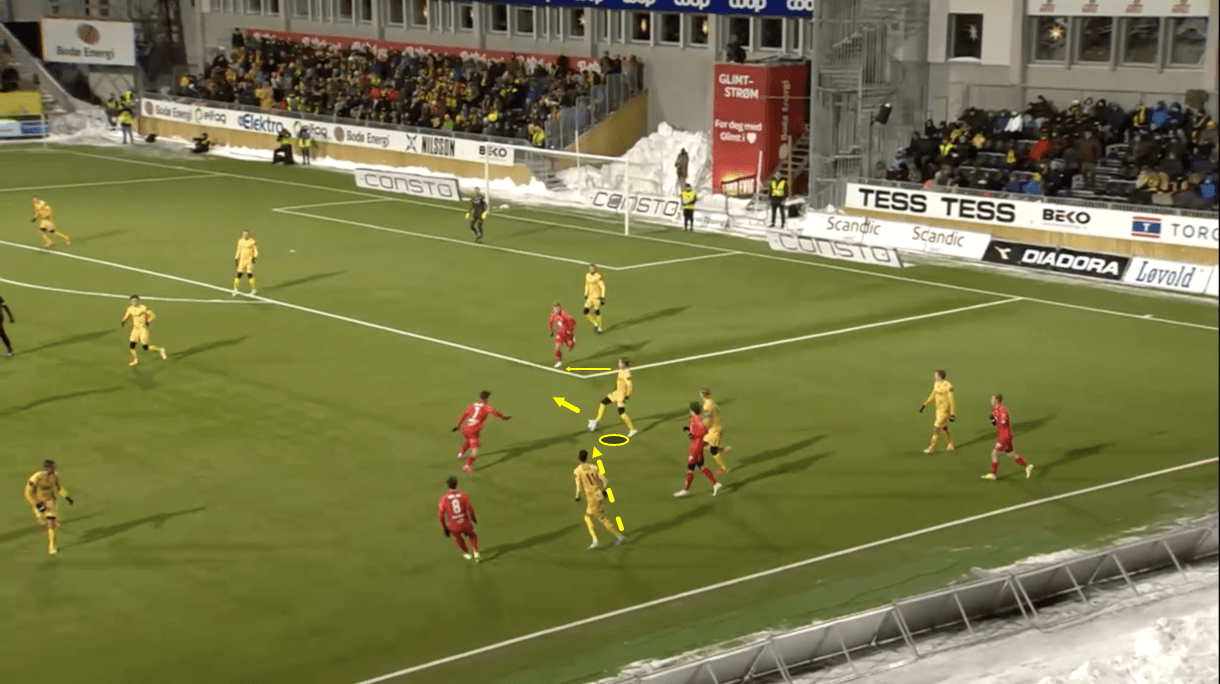
As play moves on into figure 12, we see Berg again receiving well similar to how we saw him receiving before, with an open body shape, turning towards the opposition’s half. This is very positive body movement that sets the 24-year-old up well to progress his team upfield from this point.
This image also shows that Berg had the chance to play the ball into midfield quickly immediately after receiving the ball here, which would’ve given his side a chance to effectively build out from the back. However, as we’ll go on to see in figure 13, Berg didn’t ultimately take this option.
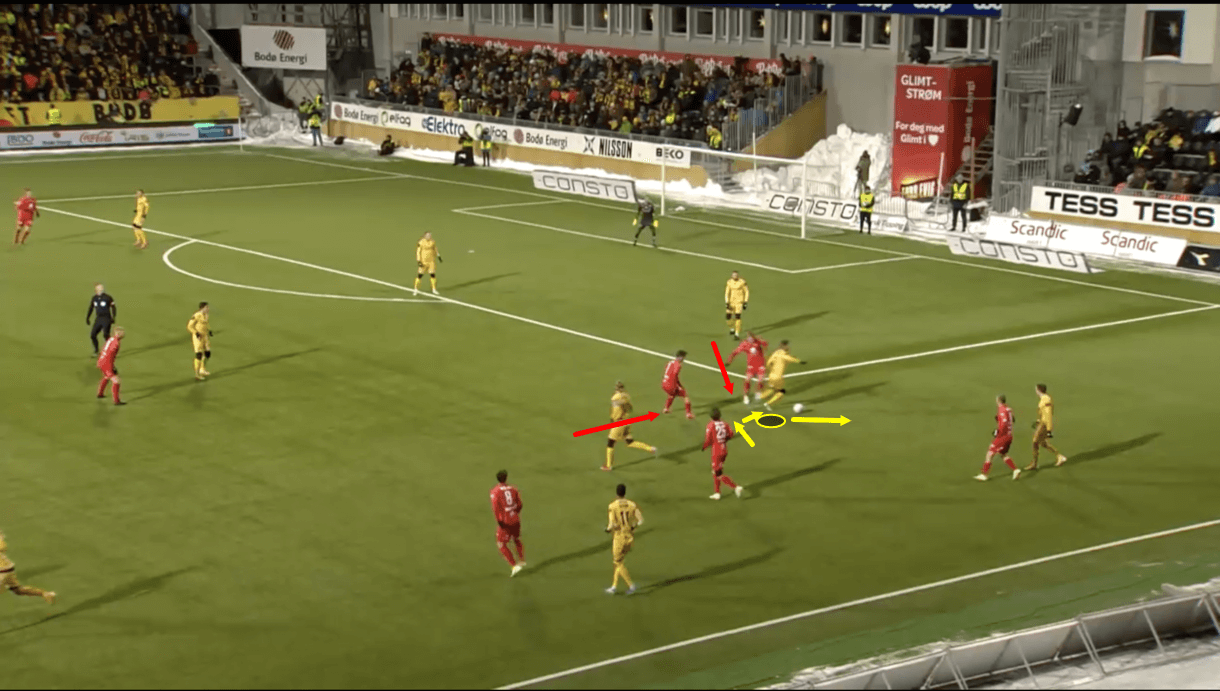
Instead, as figure 13 shows, Berg wasn’t comfortable with playing the ball into the centre and opted to turn back towards his own goal, drawing further pressure onto himself and ultimately leading to the 24-year-old getting rushed into playing a clearance with his weaker left foot that led to a turnover, albeit in a less threatening position further upfield than if he’d just lost possession on the edge of his own box, where we see him above.
Granted, Berg’s option in the centre did have incoming pressure from the defender we now see right behind him but I feel playing the ball into him, especially earlier than this point we see in figure 13, would still have been a far better option than the one the midfielder took. The receiver could have received and even if he were prevented from turning to face the opposition’s goal, there were better passing options, such as a couple of runners ahead of Berg on the left-wing or even a pass back to the centre-backs, that would’ve been possible to find and that would’ve left Bodø/Glimt in a better position than they ultimately ended up in.
This highlights how Berg can sometimes be too cautious and possibly not trusting enough when playing out from the back, which can hinder him when playing in such an important position as the sole holding midfield role in Bodø/Glimt’s 4-3-3. Berg can work on putting more trust in his teammates, his own passing ability and his bravery in possession to improve his decision-making in situations like this in the future. This would likely benefit his play and his team’s attacking threat in the long run, considering his excellent technical ability to pull off passes like the one he could’ve played here and should back himself to play in the future.
Not a dribbler
While Berg’s proficiency in helping his side to progress upfield via his passing should now be clear, the same can’t be said for Berg’s dribbling and ability to progress his team upfield via carries. Simply put, the 24-year-old Bodø/Glimt man is not a dribbler. Berg has made just 0.97 dribbles per 90 this season, which ranks very low among Eliteserien midfielders. Berg has also made just 0.79 progressive runs per 90 this term, which similarly ranks low among Eliteserien midfielders.
Lens fans shouldn’t expect Berg to carry the ball as much as current midfield duo Cheick Doucouré and Seko Fofana. Both of those players get forward and take opposition players on via dribbles frequently but Berg isn’t that player. He’s not the most agile or the kind of technically sound dribbler who you’ll see winding through opposition defenders with the ball glued to his feet, rather he progresses via his passing quality and off-the-ball movement which we analysed in the previous section of analysis.
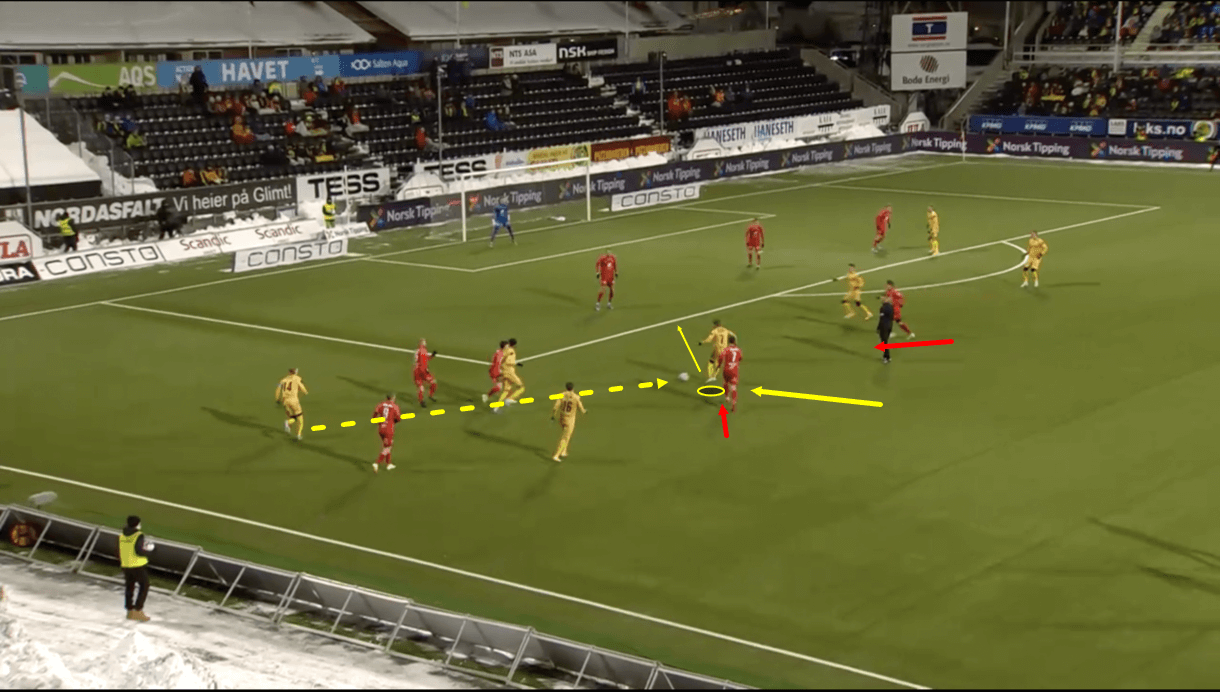
One thing that Berg is great at which does help him to get past opposition players is receiving the ball. Figure 14 provides an example of one such occasion when Berg beat an opposition defender by receiving the ball in such a way that it deceived the defender and helped him to go past. In this example, Berg has received a pass in the final third just outside the box. Meanwhile, he has one opposition player on his tail and another beginning to press him from his right. At this moment, with the ball arriving at his right foot, the midfielder’s body shape suggests that he’s set to carry the ball forward into the box, which is what the two players pressing him also anticipate and ready themselves to defend against.
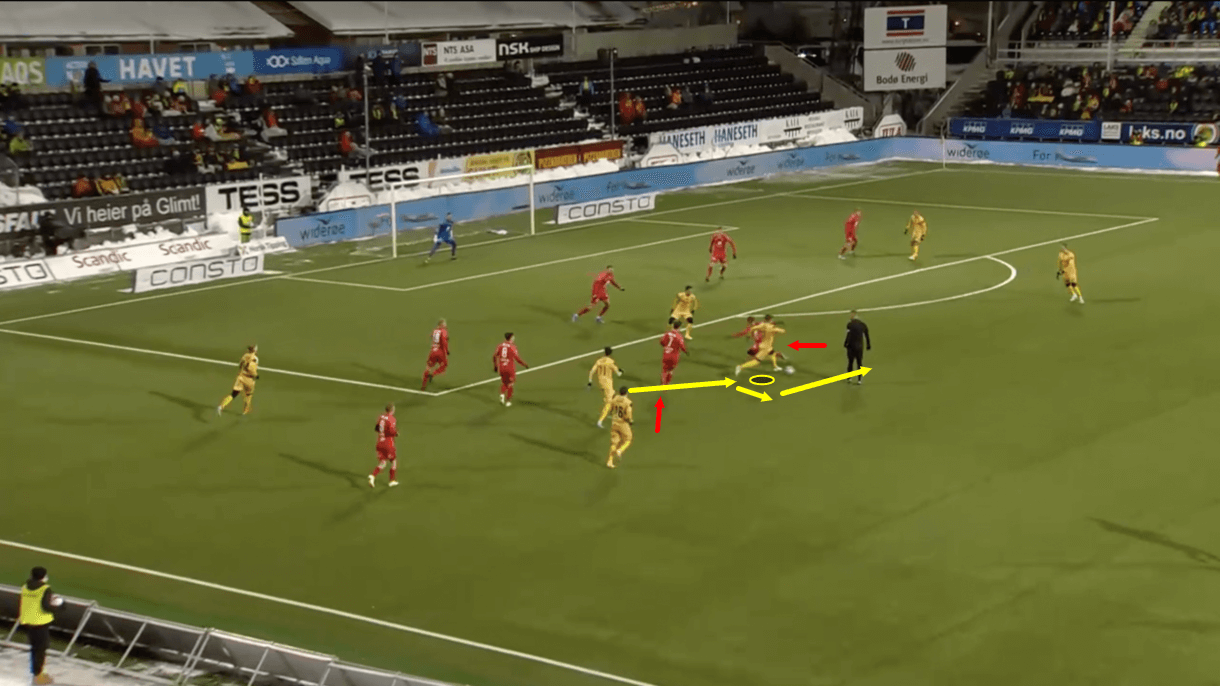
However, as play moves on into figure 15, we see that the midfielder deceived the opposition by allowing the ball to run across his body instead of immediately taking a first touch forward as the ball arrived. This caught the defenders off guard and as we can see, it helped Berg to get around the defender pressing from the right, as that player who’d been sprinting to get into the position he thought he needed to occupy to defend against Berg was now off-balance when Berg was dribbling towards him. As play moved on from here, we see Berg get around this player without much difficulty and progress into a very threatening central position on the edge of the box with time, space, and passing options ahead of him.
As I stated at the beginning of the previous section, this is the kind of position in which Berg really thrives so his intelligent movement on receiving the ball here really proved helpful for the 24-year-old.
Again, Berg isn’t a great dribbler by any stretch and you shouldn’t expect him to set off on long winding runs. However, he’s very good at pulling off subtle movements just before and immediately on receiving the ball to get around defenders.
Shooting
As mentioned at the beginning of this analysis, Berg managed to score three league goals for Bodø/Glimt this season, and he managed to score those three goals from an xG of 4.08. Both Berg’s goals tally and his xG rank quite highly among Eliteserien central midfielders, which is a testament to his goal threat.
Berg took 1.5 shots per 90 this season (a fairly high number of shots for an Eliteserien midfielder), with a 32.5% shot accuracy rate (average for an Eliteserien midfielder). He also had a shot conversion rate of just 7.5%, which is slightly below average among Eliteserien midfielders.
This data isn’t very surprising because Berg does like to get forward into shooting positions quite often. He’s happy to progress into the box if there’s space for him to drive into but more often, we see Berg taking one/two-touch long shots from the edge of the area. These long shots are naturally lower quality chances than the average striker will typically get from inside the box just due to the distance from goal and as a result, most of his shots fail to hit the target or get converted into goals.
Berg is very comfortable hitting shots off one or two touches, hence why he tended to do this for Bodø/Glimt. He varies up his shooting technique depending on the situation, sometimes hitting a powerful but low and controlled drive with the inside of his right foot and other times hitting a low powerful shot with the laces — these shots can often even just come off the outside of his right boot, putting a slight bit of backspin on the ball which can make it difficult for the opposition goalkeeper to stop them. This tendency to vary his shooting techniques can make Berg somewhat less predictable for defenders as he’s comfortable hitting shots in different ways, and he’s capable of doing so very effectively.
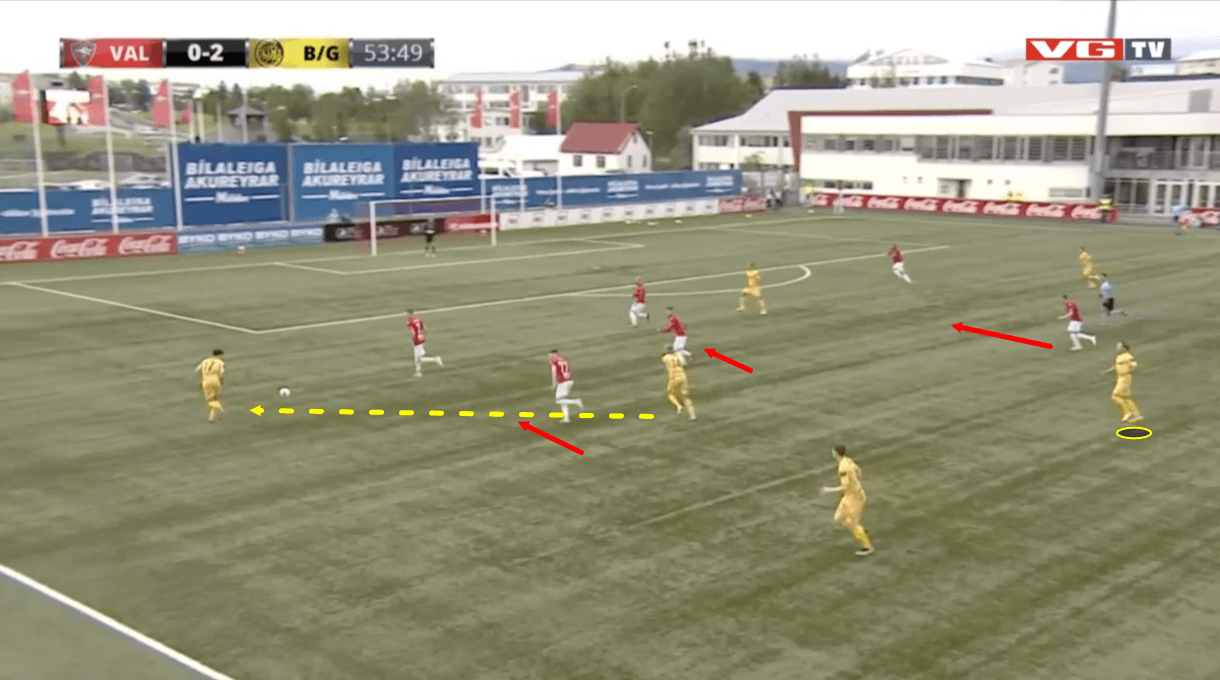
The ability to arrive late in the box is often referenced in discussions around midfielders’ goal threat, as this type of movement makes them more difficult for defenders to pick up, and this is an evident skill in Berg’s game. Figures 16-17 will examine one passage of play in which Berg exhibited this ability to arrive late to attack the box for Bodø/Glimt. Firstly, figure 16 shows Bodø/Glimt attacking their opponents via the left wing. The ball carrier here has space to run into and as a result, the opposition are tracking back to get bodies behind the ball.
At this moment, the opposition aren’t focusing on Berg in his deep-lying position with play having progressed beyond him, which puts him in a somewhat ‘out of sight, out of mind’ position. However, Berg doesn’t view himself as being out of the game at this point, and instead uses this opportunity to find some space to attack by roaming about and scanning the space ahead of him, similar to what we observed from him in our ‘passing’ section.
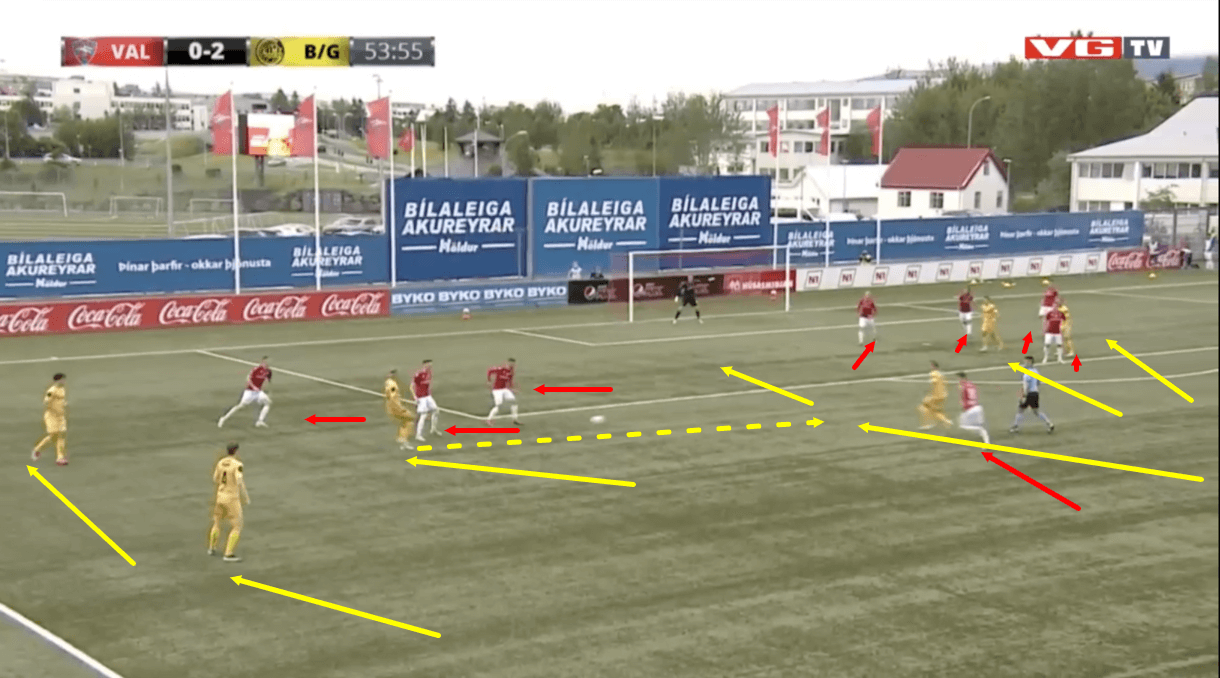
As play progressed into figure 17, we see that Berg found some space to attack via his late run from deep as the opposition’s defensive shape split when Bodø/Glimt continued to build their attack via the left wing. The left central midfielder and left-back got forward to support the ball-carrying left-winger for Bodø/Glimt, attracting three opposition players to that wing to defend against them, while Bodø/Glimt’s other attackers stayed more centrally or on the right. This created a gap between the opposition defenders marking the central attackers and those marking Bodø/Glimt’s left-sided attackers, and this gap became Berg’s channel to drive into.
As we pick up the play in figure 17, we see that the nearest opposition defender can only chase Berg as he receives the ball played into his running path from the left central midfielder positioned wide on the left wing. From here, we see Berg control the ball well by taking it in his stride and driving into the penalty area with it. The midfielder then went on to finish the chance by striking across goal into the far corner of the net with his weaker left foot (which is relatively strong as far as weaker feet go).
What’s more notable than Berg’s actual finish here, though, was his off-the-ball movement before receiving the ball and his alertness to the positioning and movement of players closer to the ball ahead of him. This shows why he’s so good when operating in a slightly deeper role when his side enters the final third. He’s got excellent vision and scans so effectively that he’s able to spot opportunities to drive forward and exploit space as it opens up in the attacking third. As we saw in this example and other previous examples, this movement from Berg can be crucial in his team’s ball progression and chance creation. As we saw in this latest case, it can also help Berg to forge a goalscoring opportunity in a quality position for himself, so it’s a very valuable skill for the Norwegian midfielder
Defensive qualities
For the final section of this scout report, I want to spend some time highlighting what Berg is and what he isn’t defensively. In somewhat of a contrast to how he plays when Bodø/Glimt were in possession, Berg wasn’t incredibly active in defensive phases for the Norwegian side. When playing for Bodø/Glimt in a typical structured defensive phase, the high-block phase, mid-block phase or low-block phase, the 24-year-old tended to operate in a more disciplined manner, not running around seeking out defensive engagements but instead trying to position himself well between the lines to block opposition players’ channels for progression and potential passing lanes. Meanwhile, he’d allow the forwards and central midfielders just in front of him to act more aggressively applying pressure.
As a result of his behaviour in these phases, Berg didn’t engage in a tonne of defensive duels this season for Bodø/Glimt, with his 6.78 defensive duels per 90 ranking quite average mong Eliteserien central midfielders. Berg also made a fairly average number of interceptions for Bodø/Glimt this season (5.02 pAdj interceptions / 3.52 interceptions per 90). Furthermore, he doesn’t make a lot of fouls, with 0.75 per 90 ranking very low among Eliteserien midfielders.
All of this is partly a result of Berg’s playing style and preferences, along with being partly a result of his role at Bodø/Glimt as the sole holding midfielder who needed to be more focused on maintaining a good position in front of the defensive line than the midfielders ahead of him did. This typically resulted in Bodø/Glimt operating with a solid defensive structure that set the 24-year-old up for success when he did need to engage in defensive duels just through his good positioning. When Berg did engage in defensive duels for the Eliteserien champions this season, he was generally successful, winning 70.17% of his defensive duels — a very impressive number.
This also highlights the benefits Berg offers his side in defensive transitions, as he was required to act more aggressively and engage in defensive duels more often in this phase of play. If possession was lost by one of his teammates ahead of him in the chance creation or progression phase, Berg was required to press far more aggressively than he was in other phases of play, while still being mindful of the options behind him and aiming to keep them in his cover shadow where possible. His primary goals in this phase were to prevent the ball carrier from moving upfield and to buy his teammates some time to get back into their organised defensive shape, and the Norway international typically performed this role to a high standard with Bodø/Glimt.
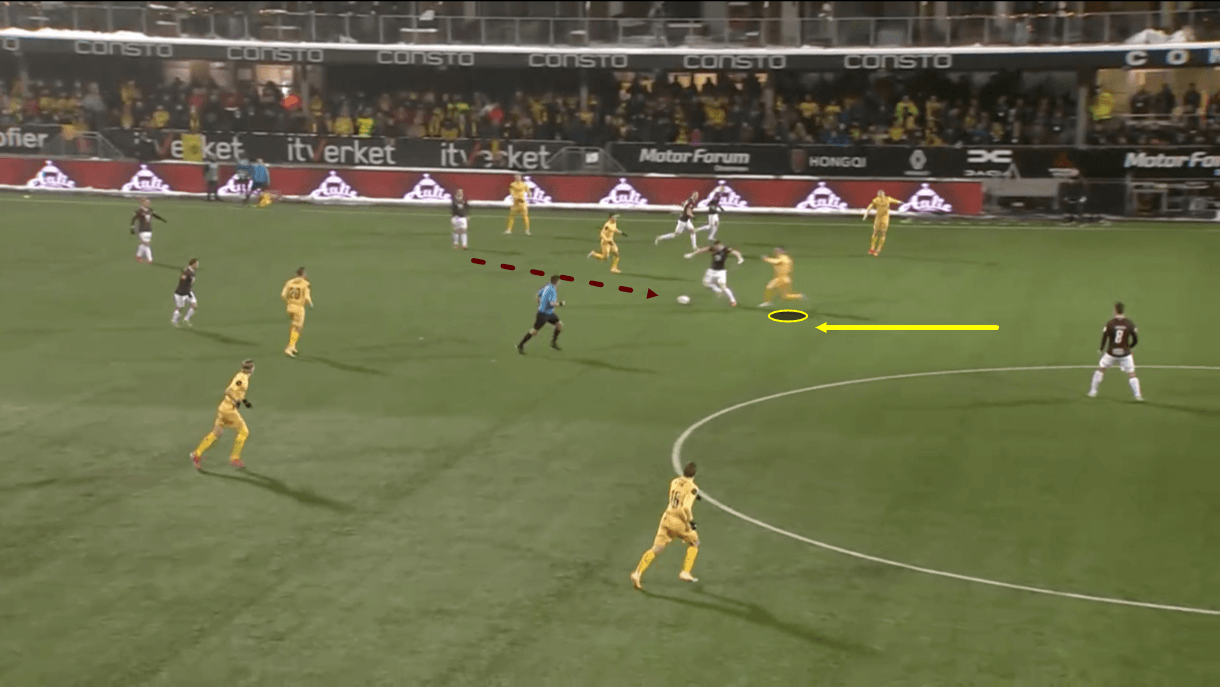
Take figures 18-19, for example. Here in figure 18, we see Berg charging forward from deep to press an opposition midfielder as he receives the ball to feet in the middle third. Berg gets tight to the receiver and into the passing lane between them and the other attacking player we see in a more advanced central position. In doing so, he prevents the ball carrier from turning and presents a constant threat to the ball despite not winning the physical battle with the larger opposition midfielder. Berg can be tenacious and aggressive when required and this is an excellent example of how that benefitted Bodø/Glimt.
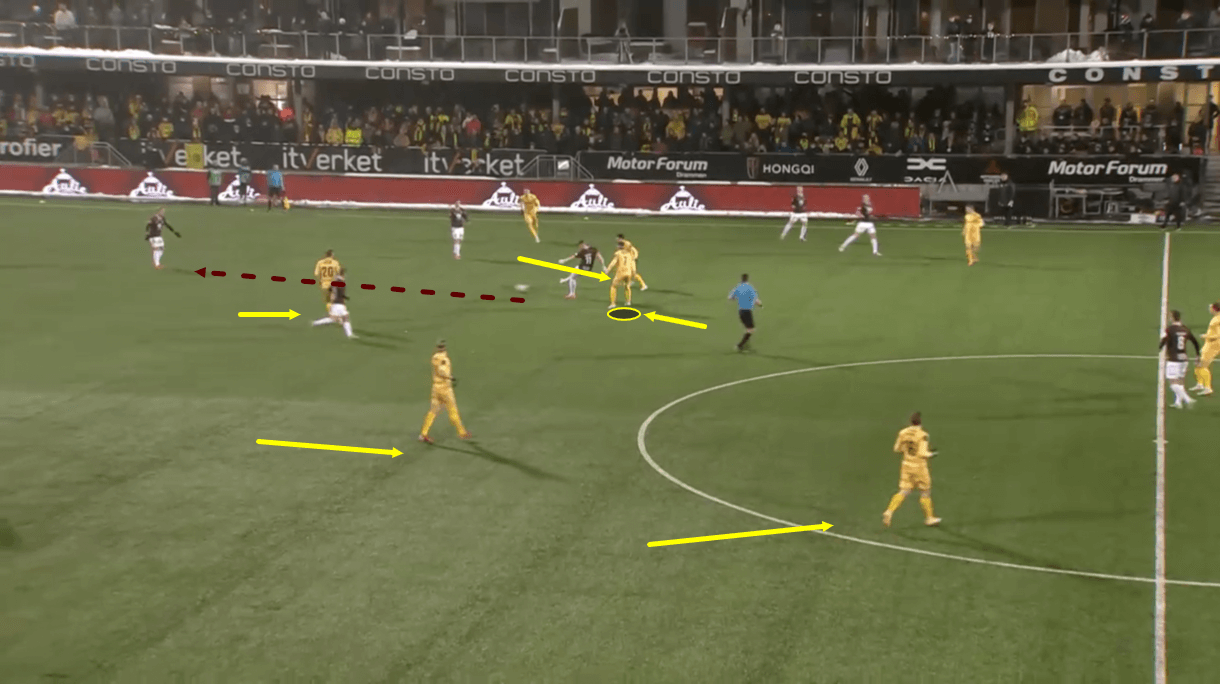
As play moves on into figure 19, we see firstly that the opposition midfielder has been forced to pass the ball backwards by Berg through his relentless pressure, which is success for the Norwegian in the first goal of preventing progression. Meanwhile, if you compare the Bodø/Glimt players’ positioning in figure 18 to figure 19, we can see that Berg’s pressure bought his teammates time to get back into a far more organised defensive shape than they’d been in previously, making them a far more difficult team to break down than they were previously when in transition.
This is a good example of Berg’s defensive qualities, while he’s not very big and menacing at 175cm, he’s more than comfortable defending aggressively when required and capable of doing so successfully even against larger opponents and even when the receiver in transition is deployed even deeper, on the edge of their own box, in transitions. His strength lies in knowing when and when not to press like this and in his role at Bodø/Glimt, he was mainly required to press like this in transitions while acting in a more disciplined manner a lot of the time. This skill of knowing when and when not to do this, even if deployed in a different role at Lens, will make the 24-year-old a good asset for his new team in defensive phases.
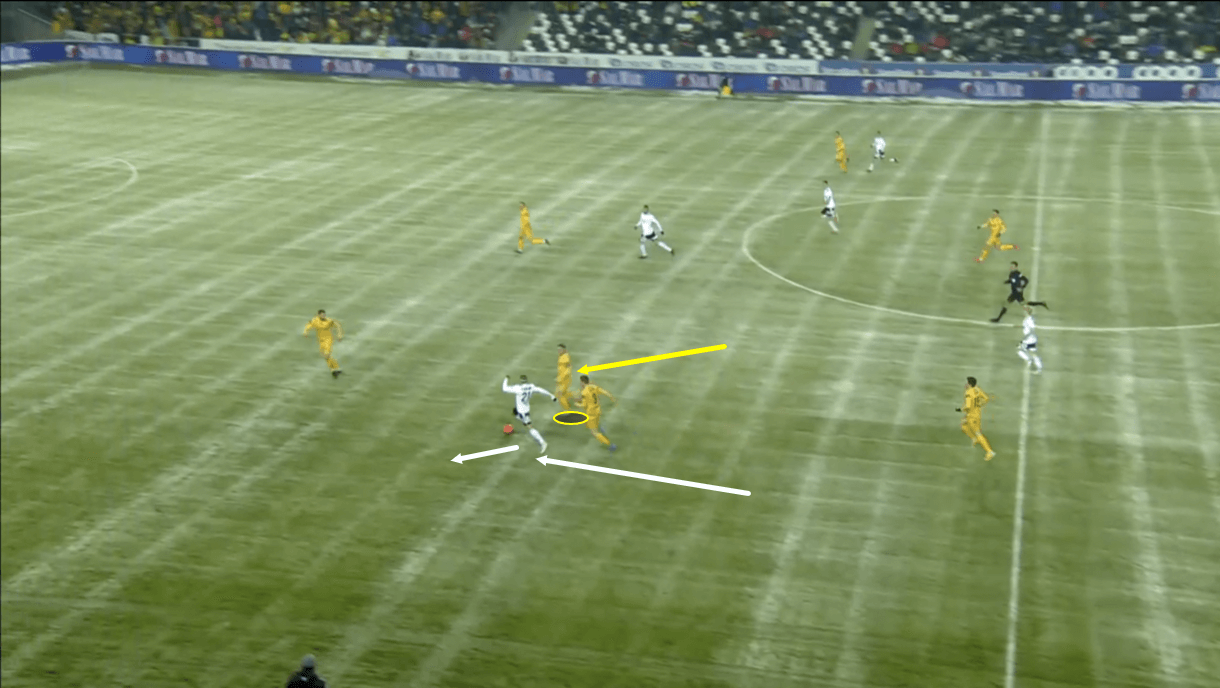
Sometimes the opposition did manage to progress beyond Berg, typically via the wings, on the counter-attack and the holding midfielder was required to be calm, focused on good positioning, and active in his pressing when this happened. He didn’t need to be extremely aggressive a lot of the time but did need to be present in the right position, closing in on the ball carrier to some extent. Figure 20 shows an example of Berg tracking back to close down an opposition attacker carrying the ball forward on the left wing on the counter. Here, Berg immediately got back and closed in on the ball carrier while remaining more central than the opposition attacker. He also intelligently made sure to position himself between the ball carrier and the central passing options to ensure these players weren’t an outlet for the ball carrier to use and progress past Berg to attack Bodø/Glimt’s backline.
When the opposition managed to progress to a more advanced stage of the counter-attack as we see above, it was very common to see Berg act as he did above, which was generally quite effective and useful for his side in 1. preventing the opposition attacker from moving further forward and 2. Forcing the opposition attacker into a less threatening position. We see an example of 1 and 2 in figure 20 above.
On being prevented from progressing into the centre further or running straight at Bodø/Glimt’s backline by Berg, the opposition attacker was forced to take the ball wider while turning his back to the centre. This was the moment at which the team in control of this counter-attack switched from the opposition to Bodø/Glimt, as now Berg was able to press even more aggressively with the centre and backline less threatened.
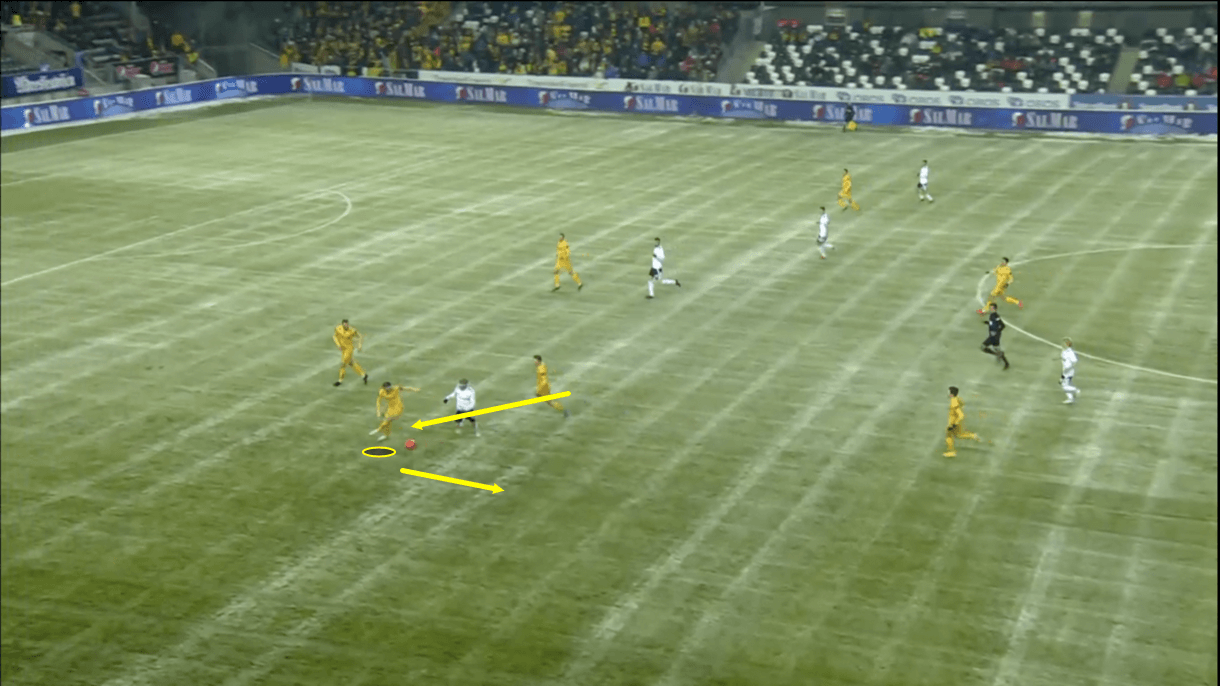
As this passage of play moved on into figure 21, we see that Berg ultimately ended up pouncing on a heavy touch by the opposition attacker while he tried to turn out towards the wing. Berg’s aggressive pressure was deployed so that he could help force and then capitalise on some mistake from the ball carrier, which is what happened. This is an example of some intelligent, effective pressing from the 24-year-old midfielder. As this passage of play moves on from here, we see Berg gain control of the ball for Bodø/Glimt and kickstart a counter-attack of their own.
Berg isn’t perfect in defensive phases — if isolated 1v1, his defensive technique isn’t always perfect and he can be beaten by a good dribbler. Bodø/Glimt did a good job of protecting the midfielder from being exposed in 1v1s often, however, which resulted in his very impressive success rate in defensive duels. However, at times Berg fails to get his body behind the ball when engaging in defensive duels, simply sticking a foot out which isn’t always enough to stop the dribbler even if he gets that foot on the ball. So working on his technique when entering defensive duels could be a good area for the midfielder to focus on in order to improve his ability if forced to engage in 1v1s in the future.
Conclusion
To conclude this tactical analysis and scout report of Berg, I think the midfielder’s main strengths lie in his ball retention and ball progression abilities, along with his creative, defence-splitting passing ability in more advanced areas. He’s proficient in not just scanning, but scanning effectively and at receiving the ball with a positive, open body shape. However, Berg can improve his decision-making, positioning, and bravery in possession, especially in deeper areas.
Berg isn’t much of a dribbler though can beat defenders with his body shape and movement when receiving the ball, he provides a solid goal threat through his shooting technique and intelligent off-the-ball movement though isn’t always great with his shot selection, and Berg typically defended well with Bodø/Glimt, as the sole holding midfielder in their 4-3-3 system, though can be beaten if exposed in 1v1s versus a decent dribbler more often. In terms of his defensive positioning and pressing when he is required to do so — particularly in defensive transitions — the midfielder is more reliable.
I don’t think Berg is very similar to either Fofana or Doucouré who’ve been playing in central midfield for Lens, though some of his characteristics lean more towards Doucouré than Fofana and I could see him being signed as a premature replacement for the Frenchman if his time at Lens is set to come to an end in the next 12 months. If Berg has been signed as an immediate starter, however, I could see Lens potentially playing him with Doucouré and Fofana as a deep-lying playmaker who’d more likely replace Gaël Kakuta in the starting XI. Lens have used a 3-5-2 rather than their usual 3-4-1-2 in a couple of recent games which may back up this possibility. I’d be interested to see Berg operating in a more advanced position too, however, and think his future may lie in the ‘number 8’ role rather than the holding midfield role.





Comments